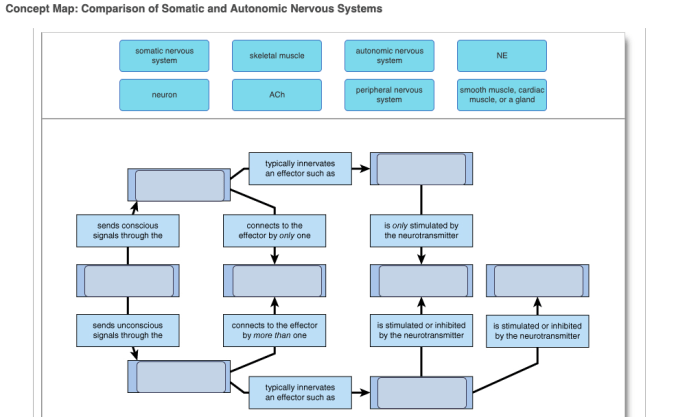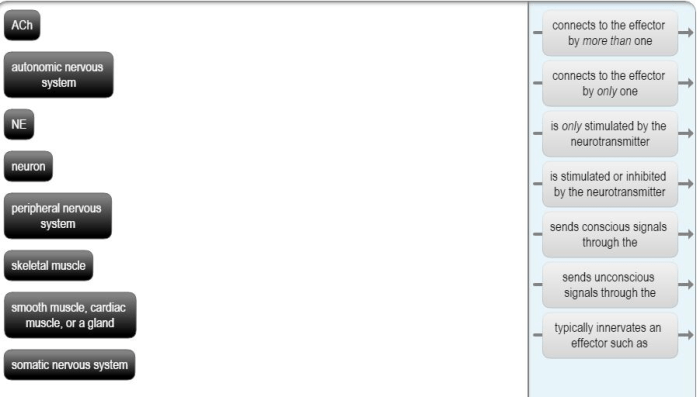Concept map comparison of somatic and autonomic nervous systems sets the stage for this enthralling narrative, offering readers a glimpse into a story that is rich in detail and brimming with originality from the outset. This comprehensive analysis delves into the intricate workings of two distinct yet interconnected systems, shedding light on their functions, structures, and the subtle nuances that set them apart.
The somatic nervous system, responsible for voluntary movements and conscious control, stands in stark contrast to the autonomic nervous system, which operates below the level of conscious awareness, regulating involuntary functions essential for survival. Understanding the interplay between these systems is crucial for grasping the complexities of human physiology and the delicate balance that maintains our well-being.
Somatic Nervous System: Concept Map Comparison Of Somatic And Autonomic Nervous Systems

The somatic nervous system is responsible for voluntary movements and sensory perception. It consists of all the nerves that connect the central nervous system to the muscles and sensory receptors in the body. The somatic nervous system is divided into two main divisions: the afferent division and the efferent division.
Afferent Division
- Carries sensory information from the body to the central nervous system.
- Consists of sensory neurons that have receptors that detect various stimuli, such as touch, pain, temperature, and proprioception.
Efferent Division
- Carries motor commands from the central nervous system to the muscles.
- Consists of motor neurons that innervate skeletal muscles, allowing for voluntary control of movement.
Autonomic Nervous System
The autonomic nervous system is responsible for regulating involuntary functions, such as heart rate, digestion, and respiration. It consists of all the nerves that connect the central nervous system to the smooth muscles, cardiac muscles, and glands in the body.
The autonomic nervous system is divided into two main divisions: the sympathetic division and the parasympathetic division.
Sympathetic Division
- Prepares the body for “fight or flight” responses.
- Increases heart rate, blood pressure, and respiration.
- Dilates pupils, inhibits digestion, and shunts blood flow to skeletal muscles.
Parasympathetic Division
- Promotes “rest and digest” responses.
- Decreases heart rate, blood pressure, and respiration.
- Constricts pupils, stimulates digestion, and shunts blood flow to internal organs.
Comparison of Somatic and Autonomic Nervous Systems

| Feature | Somatic Nervous System | Autonomic Nervous System |
|---|---|---|
| Function | Voluntary movements and sensory perception | Involuntary regulation of bodily functions |
| Structure | Afferent and efferent divisions | Sympathetic and parasympathetic divisions |
| Organization | Hierarchical, with descending and ascending pathways | Dual innervation of organs by sympathetic and parasympathetic nerves |
| Regulation | Voluntary control through the cerebral cortex | Involuntary control through the brainstem and hypothalamus |
Similarities:
- Both systems are composed of neurons that transmit electrical signals.
- Both systems have sensory and motor components.
- Both systems are essential for maintaining homeostasis.
Differences:
- The somatic nervous system controls voluntary movements, while the autonomic nervous system controls involuntary functions.
- The somatic nervous system is organized hierarchically, while the autonomic nervous system is organized dually.
- The somatic nervous system is regulated voluntarily through the cerebral cortex, while the autonomic nervous system is regulated involuntarily through the brainstem and hypothalamus.
Regulation of the Somatic and Autonomic Nervous Systems

Somatic Nervous System
The somatic nervous system is regulated voluntarily through the cerebral cortex. The cerebral cortex sends motor commands to the spinal cord, which then relays the commands to the muscles.
Autonomic Nervous System, Concept map comparison of somatic and autonomic nervous systems
The autonomic nervous system is regulated involuntarily through the brainstem and hypothalamus. The brainstem and hypothalamus receive sensory information from the body and send motor commands to the autonomic ganglia. The autonomic ganglia then relay the commands to the smooth muscles, cardiac muscles, and glands.
Clinical Implications

Somatic Nervous System
- Spinal cord injuries:Damage to the spinal cord can disrupt the communication between the brain and the muscles, leading to paralysis.
- Multiple sclerosis:An autoimmune disease that damages the myelin sheath of neurons in the central nervous system, leading to a variety of neurological symptoms, including muscle weakness and sensory disturbances.
- Parkinson’s disease:A neurodegenerative disorder that affects the basal ganglia, leading to tremors, rigidity, and impaired movement.
Autonomic Nervous System, Concept map comparison of somatic and autonomic nervous systems
- Autonomic neuropathy:Damage to the autonomic nerves, which can lead to a variety of symptoms, including orthostatic hypotension, erectile dysfunction, and gastrointestinal problems.
- Pheochromocytoma:A tumor of the adrenal glands that secretes catecholamines, leading to hypertension, tachycardia, and sweating.
- Addison’s disease:A disorder of the adrenal glands that leads to a deficiency of cortisol and aldosterone, resulting in hypotension, weakness, and fatigue.
Expert Answers
What is the primary function of the somatic nervous system?
The somatic nervous system enables voluntary movements and conscious control of skeletal muscles, allowing us to interact with our environment and perform purposeful actions.
How does the autonomic nervous system differ from the somatic nervous system?
Unlike the somatic nervous system, the autonomic nervous system operates involuntarily, regulating essential functions such as heart rate, digestion, and respiration without conscious control.
What are the key similarities between the somatic and autonomic nervous systems?
Both systems rely on neurons to transmit signals, utilize neurotransmitters to facilitate communication, and exhibit plasticity, allowing for adaptation and learning.